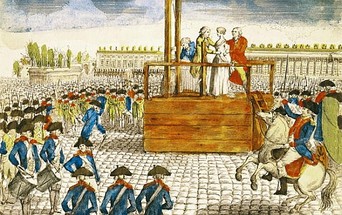Effects of the French Revolution
By Jazmin Haque and Karen Angeles
The Reign of Terror
|
The Reign of Terror began on September of 1793 and was marked by a series of violence outbreaks and mass executions of people considered the enemies of the revolution. The guillotine was a “painless” and effective way of executing those opposed to the revolution. It was responsible for executing King Louis XVI and Marie Antoinette, and it became the symbol of the revolution.
Maximilien Robespierre was one of the most powerful and influential leaders during the Reign of Terror. He was the leader of the Committee of Public Safety, which put into effect policies geared toward stabilizing the economy and forming the French Army. This committee was also responsible for many mass executions of anti-revolutionary uprisings. In the document to the right, Robespierre addresses the issue of these uprisings. The excerpt comes from a speech given on February of 1794, in which the tribunal convicted and guillotined 238 men and 31 women, and incarcerated 5,434 people that awaited trial. Robespierre argued that terror was necessary in achieving justice, and it was a consequence of the urgency in achieving democratic France. His radical policies and orders followed these beliefs, and he was eventually guillotined for threatening the National Convention. Although the Reign of Terror saw the worst of the violence of the French Revolution, it set a precedent for future government ideas. It highlighted the importance of liberty regardless of beliefs, especially in future democratic bodies to allow opposition from different political factions without the chaos that resulted from the Reign of Terror. |
Decline of the Church's PowerBefore the French Revolution, Catholicism had been the official religion of France. The French Catholic Church had been very powerful and nearly all of France’s population had been Catholic. However after the French Revolution France’s churches had lost much of their power and religious worship was not as prominent in the region as before.
During the Reign of Terror religion was attempted to be abolished in France. The Committee of Public Safety had made this attempt by creating new calendars, renaming religious landmarks, and by plundering religious buildings. An “anti-religious campaign” had been established. This included the execution of the clergy, the closing of many churches, and both public and private worship of Christianity being banned. It had been known as “dechristianisation” during the time. |
A Constitutional MonarchyDue to the success of the French Revolution and the Tennis Court Oath, many changes had taken place. One of the most important being the abolishment of the absolute monarchy in France and the implementation of a constitutional monarchy.
The Tennis Court Oath had called for the Third Estate General to take a vow to create a new constitution, effectively making the absolute monarchy obsolete when combined with the effects of Bastille Day. The constitutional monarchy was made to be governed by a monarch but controlled and checked by a parliament. This government system had created and encouraged a more democratic state in France and allowed for reduced influence of the upper class and had increased the powers of the middle and lower classes. The Declaration of the Rights of Man and of the Citizen had been published by the National Constituent Assembly in August of 1789. This declaration had not been a new constitution exactly, but instead had been a “body” or draft of a future constitution. In 1791 the publication of the Constitution of 1791 had been presented as France’s official constitution. |
Long Term Effects of the Revolution
|
The French Revolution had many lasting results. It unified and increased the power of the national state. It increased the feeling of French nationalism, and it set a precedent for a democratic French government. Although it did not solve class inequalities, the French Revolution led to the emergence of the middle class.
The Revolution also gave way to the reign of Napoleon Bonaparte. He established the Code of Napoleon, which made the legal system fairer to the French regardless of wealth or religion, and it had a greater impact on the lives of peasants as opposed to other reforms by ineffective leaders. |
Works Cited
"French Revolution." Infoplease. Infoplease, n.d. Web. 28 Mar. 2013.
"The "Code Napoleon" (1804)." The "Code Napoleon" (1804). N.p., n.d. Web. 28 Mar. 2013."French Revolution." French Revolution. N.p., n.d. Web. 29 Mar. 2013. <http://www.talktalk.co.uk/reference/encyclopaedia/hutchinson/m0003820.html>.
"French Revolution." Wikipedia. Wikimedia Foundation, 30 Mar. 2013. Web. 29 Mar. 2013. <http://en.wikipedia.org/wiki/French_Revolution>.
PBS. PBS, n.d. Web. 29 Mar. 2013. <http://www.pbs.org/marieantoinette/timeline/reign.html>.
"Reign of Terror." Wikipedia. Wikimedia Foundation, 29 Mar. 2013. Web. 29 Mar. 2013. <http://en.wikipedia.org/wiki/Reign_of_Terror>.
"The "Code Napoleon" (1804)." The "Code Napoleon" (1804). N.p., n.d. Web. 28 Mar. 2013."French Revolution." French Revolution. N.p., n.d. Web. 29 Mar. 2013. <http://www.talktalk.co.uk/reference/encyclopaedia/hutchinson/m0003820.html>.
"French Revolution." Wikipedia. Wikimedia Foundation, 30 Mar. 2013. Web. 29 Mar. 2013. <http://en.wikipedia.org/wiki/French_Revolution>.
PBS. PBS, n.d. Web. 29 Mar. 2013. <http://www.pbs.org/marieantoinette/timeline/reign.html>.
"Reign of Terror." Wikipedia. Wikimedia Foundation, 29 Mar. 2013. Web. 29 Mar. 2013. <http://en.wikipedia.org/wiki/Reign_of_Terror>.





